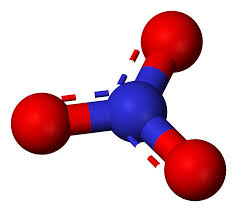Nitrite Formula
Nitrite is an inorganic ion that has a negative charge. It is a component of many salts such as sodium nitrite and potassium nitrate. These salts are available in the food contents. This article will deal with the concept of Nitrites and Nitrite formula with examples. Let us learn it!

Source: en.wikipedia.org
Nitrite Formula
What are Nitrites?
It is quite an important formula with the perspective that nitrite is a type of an ion that is the source form many chemical compounds. Nitrite ion is popular to form bonds with metal in different ways as well as other chemical elements or compounds.
Nitrites are the symmetric anion. It consists of 1 Nitrogen and 2 Oxygen atoms. It appears as a colorless liquid or crystalline solid. One can produce these by the absorption of nitrogen dioxide and nitric oxide using an alkaline solution.
The formula for Nitrite
Its chemical formula is,
It is formed by a nitrogen anion, which is joined to two oxygen atoms through the covalent bonds. Two oxygen atoms are sharing the negative charge through a resonance effect. The nitrite ion is having the symmetrical structure which has an inverted V shape with central N and the two oxygen atoms.
Properties of Nitrite
A nitrite ion is a type of Lewis base. Apart from this, it may also act as an ambidentate ligand in the presence of some metal. In this case, it will donate a pair of electrons from either oxygen or the nitrogen atom.
In the case of sodium nitrite, it is a white crystalline solid and having the melting point of
The nitrite ion is very unstable under some conditions due to one negative charge. As an example, we may see that the ingestion of sodium nitrite by humans can suffer a notarization chemical.
Solved Examples
Q.1: What is the difference between Nitrite and Nitrate?
Solution: We may use Nitrite and Nitrate interchangeably because of their similar pronunciation and spelling. Both are inorganic compounds having N and O atoms. Due to the difference between numbers of oxygen atoms, there are differences in the structure, shape, and function. Nitrites have one nitrogen atom and two oxygen atoms but on the other hand, nitrates have one nitrogen atom and two oxygen atoms. The oxidation number of nitrogen in nitrites is +3, whereas in nitrates it is +5. Nitrates form a weak acid which is nitrous acid, whereas Nitrites form strong acid which is nitric acid.
Q.2: What are some uses of Nitrites?
Solution:
- It prevents bacterial growth and hence used for curing of meat.
- Nitrite is used in the form of salt as an additive in meat curing
- Medically it is used as a vasodilator to relieve the cardiac pain.
- It is added to processed meats such as bacon, hot dogs, and sausages.
- It functions as antimicrobial in the digestive system to help kill the pathogenic bacteria such as Salmonella.
Q.3: Determine the molar mass of Nitrite.
Solution: Its formula is:
So, its molar mass will be,
=
= 46.005 gram per mole.
Thus its molar mass will be 46.005 gram per mole.